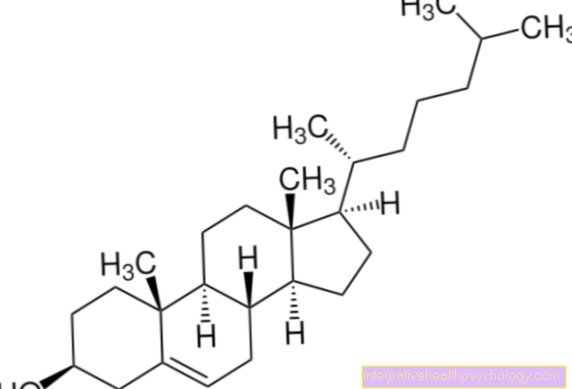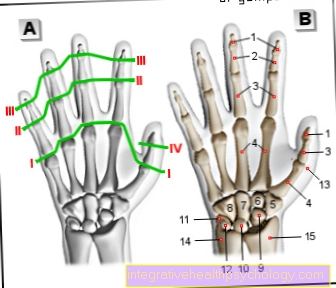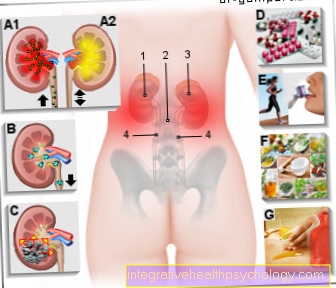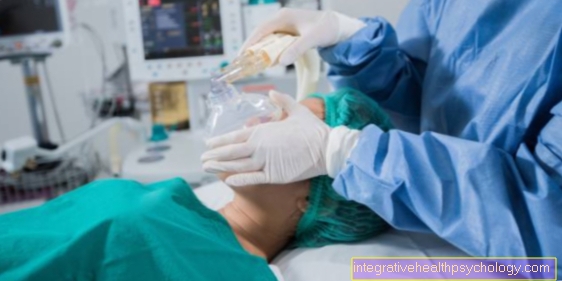Stages of anesthesia
definition
The American anesthesiologist Arthur Guedel determined in studies in 1920 that anesthesia consists of different stages. These are differentiated on the basis of reflexes, the pupil size, the movements, the pulse, the respiratory drive and the consciousness of the patient.
Guedel observed these stages in ether anesthesia and they can only be transferred to pure gas anesthesia and not to the venous anesthesia that is often used today. Adding opioids, for example, leads to completely different pupil sizes.
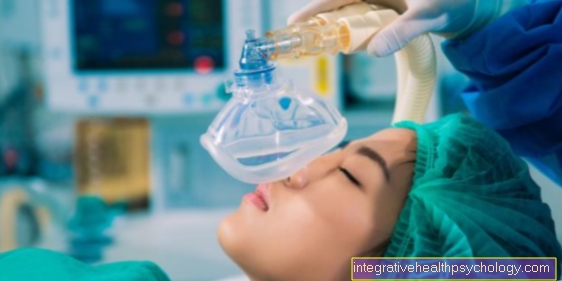
How many stages of anesthesia are there?
According to Arthur Guedel there are four stages of anesthesia. The first stage is the analgesic and amnesic stage. Then the excitation stage begins. The third stage is called the tolerance stage and the fourth stage is poisoning. These stages can only be clearly observed with pure gas anesthesia. Since pediatric anesthesia are often initiated with gas, the staging can still be seen.
Stage 1
Stage one describes the analgesia and amnesia phase. This begins as soon as the anesthetist turns on the gas. First, the sensory areas of the cerebral cortex are paralyzed. The sensations to temperature and pressure decrease. Initially, the patient is not completely free of pain, but the pain sensation is reduced.
The patient is also still conscious and can describe himself that he is getting tired and dawning. The muscle tone, i.e. the ability to tense muscles yourself, is still there. The reflexes can also still be triggered normally. This can be tested by simply tapping the kneecap tendon with the reflex hammer.
The circulation and breathing still function without restriction. The pupil motor skills are also not yet restricted. The pupils become smaller when exposed to light and then larger again. If the anesthetic is stopped at this stage, the patient may have slight memory gaps. Stage one ends with complete loss of consciousness.
Stage 2
Guedel called the second stage the excitation stage.This stage begins with complete loss of consciousness. The anesthetic gas leads to a central attenuation in which no controlled impulses can be emitted from the cerebrum. Instead of the controlled impulses of the cerebrum, uncontrolled impulses are triggered by the midbrain.
These lead to sudden muscle twitches. Therefore, when gas is introduced, children must lie securely and be buckled up so that they cannot fall off the operating table. Those affected are unconscious and salivate profusely. The sensation of pain is further reduced. The circulation, i.e. the blood pressure and pulse, and the muscle tone initially increase and the reflexes also become stronger.
This is due to the fact that the cerebrum normally dampens reflexes and this dampening now fails. Those affected also have a strong urge to urinate and may lose urine. Breathing is still almost normal, but it can be a little irregular.
The pupils are wide. One danger at this stage is vomiting and subsequent inhalation of the vomit, which can lead to pneumonia. The excitation stage does not last long and ends with the beginning of the tolerance phase.
Read more about this: Anesthetic gas
Stage 3
The third stage is the tolerance stage and the desired state during the surgical procedure. The beginning of this stage is the end of the involuntary muscle twitches. The cerebrum, midbrain and also the spinal cord are now completely inhibited. This leads to the elimination or severe inhibition of reflexes and muscle tone.
The muscles relax and thus offer good operating conditions. The sensation of pain is completely switched off. Breathing is weakened and irregular, so that artificial help is needed here. Blood pressure and heart rate also drop.
The pupils are initially narrow and then become large again in the course of the third stage. This stage can be maintained for a long time by closely controlling the amount of gas and the patient can be woken up from this stage after the end of the procedure. A slide into the fourth stage is avoided and is shown by a complete cessation of self-breathing.
Stage 4
The fourth stage of anesthesia according to Guedel is poisoning. The beginning of this stage is marked by the absence of self-breathing. The regulatory centers for breathing and circulation, which are located in the brain stem, are paralyzed and both circulation and breathing are further lowered.
The pupils are set as wide as possible and no longer react to light. The muscle tone and reflexes are no longer present. The poisoning stage ends with the breakdown of the circulation. In Guedel's day, this was a death sentence for the patient. Today it is still possible to save the patient with artificial respiration and medication to stabilize the circulation.
There is no antidote to anesthetic gases, but the gas can be exhaled more quickly by flooding with oxygen from the anesthetic machine. Without intensive medical treatment, the brain and other organs are under oxygen supply.
This article may be of interest to you: Circulatory disorder in the brain
Long-term damage is possible even if the poisoning survives. The poisoning stage is rarely reached today, since anesthesia is carried out with a mixture of drugs and the gas can therefore be dosed less.
At this point, the editorial team recommends informing yourself about the possible risks of anesthesia. Read our article on this: Risks of anesthesia







